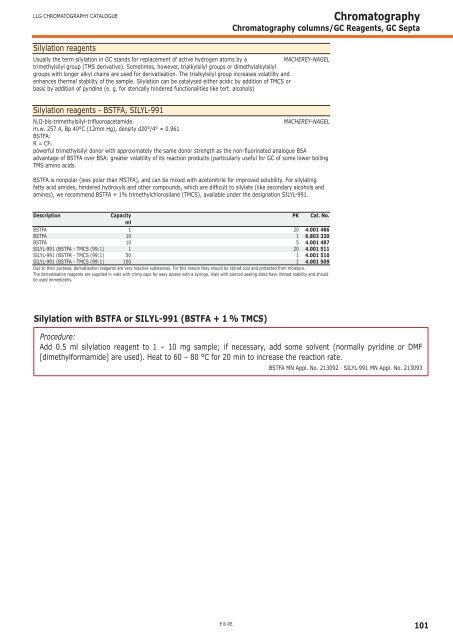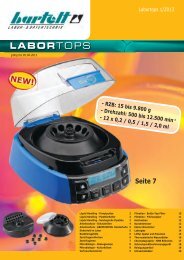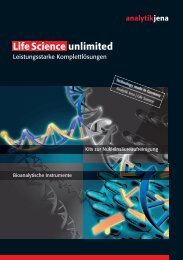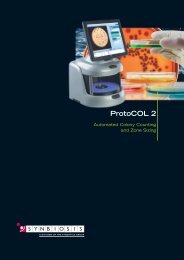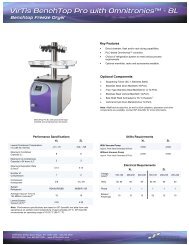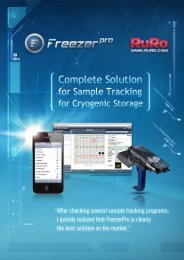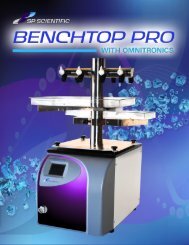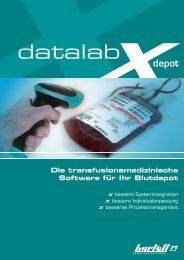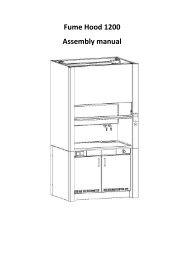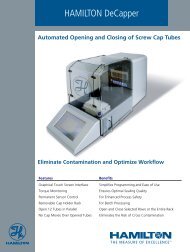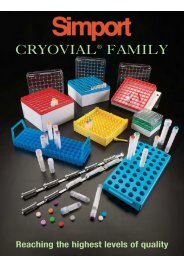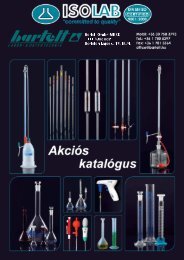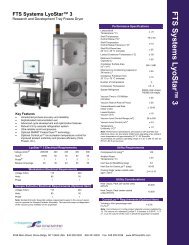<strong>Chromatography</strong><strong>Chromatography</strong> columns/GC Reagents, GC SeptaLLG CHROMATOGRAPHY CATALOGUEAcylation reagents for GC - Anhydridesby-products of acylation with anhydrides: corresponding acidsMACHEREY-NAGELexcess reagent and the acid formed have to be removedAcylation with fluorinated acid anhydrides can be used for alcohols, phenols, carboxylic acids, amines,amino acids and steroids forming volatile, stable derivatives suited for FID as well as for ECD detection.Heptafluorobutyric acid anhydride (HFBA)m.w. 410.06, Bp 106 - 107°C (760mm Hg),C3F7 - CO - O - CO - C3F7density d20°/4° = 1.665HFBAHFBAHFBACapacity PK Cat. No.ml120 4.001 480101 4.001 479105 4.001 481Methods for acylationAcylation with fluorinated acid anhydrides:Acylation with HFBA can be used for alcohols, phenols,carboxylic acids, amines, amino acids and steroids formingvolatile, stable derivatives suited for FID as well as forECD detection.Procedure:Dissolve 0.1 to 1 mg of the sample in 0.1 ml solvent,add 0.1 ml HFBA and heat to 60 – 70 °C for 1 – 2hours. If the sample need not be concentrated priorto the analysis and if there is no danger of catalyticallyinduced side reactions, pyridine is used as solvent.The reaction solution can be injected directly into thegas chromatograph. Otherwise use a volatile solventand evaporate solvent, excess derivatisation reagentand free acid in a stream of nitrogen. Dissolve theresidue in 50 μl hexane, chloroform etc. and injectaliquot portions.MN Appl. No. 213042Acylation with fluorinated acid amides:This method is recommended for alcohols, primary andsecondary amines as well as thiols under mild, neutralconditions. MBTFA also forms very volatile derivatives withcarbohydrates [J. Sullivan and L. Schewe, J. Chromatogr. Sci.15 (1977) 196 – 197].Procedure:Add 0.5 ml MBTFA to about 2 mg sample. If there isno reaction at ambient temperature, heat the reactionmixture to 120 °C. Compounds which are difficult todissolve, can be trifluoracetylated in suitable solventmixtures. It is recommended to use a ratio of solventto MBTFA of 4 : 1. The reaction mixture can be chromatographeddirectly.MN Appl. No. 213051Acylation reagents for GC - Bisacylamidesby-products: corresponding neutral acylamides, which can be easily removed due to theirMACHEREY-NAGELhigh volatility; because of neutral conditions and favourable chromatographic propertiesoften removal of the bisacylamide is not necessary. Thus sample preparation is much more convenient.Acylation with fluorinated acid amides is recommended for alcohols, primary and secondary amines as well asfor thiols under mild, neutral conditions. MBTFA also forms very volatile derivatives with carbohydrates.MBTFA /MBHFBAN-methyl-bis(trifluoroacetamide) MBTFAm.w. 223.08, Bp 123 - 124°C (760mm Hg), density d20°/4° = 1.55,CF3 - CO - N(CH3) - CO - CF3MBTFAMBTFAMBTFACapacity PK Cat. No.ml120 7.401 143101 7.510 796105 6.228 605Due to their purpose, derivatisation reagents are very reactive substances. For this reason they should be stored cool and protected from moisture.The derivatisation reagents are supplied in vials with crimp caps for easy access with a syringe. Vials with pierced sealing disks have limited stability and shouldbe used soon.Alkylation reagents for GC - Trimethylsulphonium hydroxideTMSH (0.2M in methanol) M.G. 94.06MACHEREY-NAGEL100TMSHTMSHTMSHCapacity PK Cat. No.ml110 7.086 147120 7.083 308105 4.001 512E & OE.
LLG CHROMATOGRAPHY CATALOGUE<strong>Chromatography</strong><strong>Chromatography</strong> columns/GC Reagents, GC SeptaSilylation reagentsUsually the term silylation in GC stands for replacement of active hydrogen atoms by aMACHEREY-NAGELtrimethylsilyl group (TMS derivative). Sometimes, however, trialkylsilyl groups or dimethylalkylsilylgroups with longer alkyl chains are used for derivatisation. The trialkylsilyl group increases volatility andenhances thermal stability of the sample. Silylation can be catalysed either acidic by addition of TMCS orbasic by addition of pyridine (e. g. for sterically hindered functionalities like tert. alcohols)Silylation reagents - BSTFA, SILYL-991N,O-bis-trimethylsilyl-trifluoroacetamideMACHEREY-NAGELm.w. 257.4, Bp 40°C (12mm Hg), density d20°/4° = 0.961BSTFA:R = CF3powerful trimethylsilyl donor with approximately the same donor strength as the non-fluorinated analogue BSAadvantage of BSTFA over BSA: greater volatility of its reaction products (particularly useful for GC of some lower boilingTMS amino acids.BSTFA is nonpolar (less polar than MSTFA), and can be mixed with acetonitrile for improved solubility. For silylatingfatty acid amides, hindered hydroxyls and other compounds, which are difficult to silylate (like secondary alcohols andamines), we recommend BSTFA + 1% trimethylchlorosilane (TMCS), available under the designation SILYL-991.Description Capacity PK Cat. No.mlBSTFABSTFABSTFASILYL-991 (BSTFA - TMCS (99:1)SILYL-991 (BSTFA - TMCS (99:1)SILYL-991 (BSTFA - TMCS (99:1)11010150100201520114.001 4866.803 3204.001 4874.001 5114.001 5104.001 509Due to their purpose, derivatisation reagents are very reactive substances. For this reason they should be stored cool and protected from moisture.The derivatisation reagents are supplied in vials with crimp caps for easy access with a syringe. Vials with pierced sealing disks have limited stability and shouldbe used immediately.Silylation with BSTFA or SILYL-991 (BSTFA + 1 % TMCS)Procedure:Add 0.5 ml silylation reagent to 1 – 10 mg sample; if necessary, add some solvent (normally pyridine or DMF[dimethylformamide] are used). Heat to 60 – 80 °C for 20 min to increase the reaction rate.BSTFA MN Appl. No. 213092 · SILYL-991 MN Appl. No. 213093E & OE.101
- Page 2 and 3:
perfectly together!Product choice
- Page 4 and 5:
Alphabetical indexLLG CHROMATOGRAPH
- Page 6 and 7:
ChromatographyVials/Ampoules, Septa
- Page 8 and 9:
ChromatographyVials/Ampoules, Septa
- Page 10 and 11:
ChromatographyVials/Ampoules, Septa
- Page 12 and 13:
ChromatographyVials/Ampoules, Septa
- Page 14 and 15:
ChromatographyVials/Ampoules, Septa
- Page 16 and 17:
ChromatographyVials/Ampoules, Septa
- Page 18 and 19:
ChromatographyVials/Ampoules, Septa
- Page 20 and 21:
ChromatographyVials/Ampoules, Septa
- Page 22 and 23:
ChromatographyVials/Ampoules, Septa
- Page 24 and 25:
ChromatographyVials/Ampoules, Septa
- Page 26 and 27:
ChromatographyVials/Ampoules, Septa
- Page 28 and 29:
ChromatographyVials/Ampoules, Septa
- Page 30 and 31:
ChromatographyVials/Ampoules, Septa
- Page 32 and 33:
ChromatographyVials/Ampoules, Septa
- Page 34 and 35:
perfectly together!Product choice
- Page 36 and 37:
ChromatographySyringes/Microlitre S
- Page 38 and 39:
ChromatographySyringes/Microlitre S
- Page 40 and 41:
ChromatographySyringes/Microlitre S
- Page 42 and 43:
Microliter SyringesFor Chromatogra
- Page 44 and 45:
ChromatographySample preparation/SP
- Page 46 and 47:
ChromatographySample preparation/SP
- Page 48 and 49:
ChromatographySample preparation/SP
- Page 50 and 51:
ChromatographySample preparation/SP
- Page 52 and 53: ChromatographySample preparation/SP
- Page 54 and 55: ChromatographySample preparation/Sy
- Page 56 and 57: ChromatographySample preparation/Sy
- Page 58 and 59: ChromatographyChromatography column
- Page 60 and 61: ChromatographyChromatography column
- Page 62 and 63: ChromatographyChromatography column
- Page 64 and 65: ChromatographyChromatography column
- Page 66 and 67: ChromatographyChromatography column
- Page 68 and 69: ChromatographyChromatography column
- Page 70 and 71: ChromatographyChromatography column
- Page 72 and 73: ChromatographyChromatography column
- Page 74 and 75: ChromatographyChromatography column
- Page 76 and 77: ChromatographyChromatography column
- Page 78 and 79: ChromatographyChromatography column
- Page 80 and 81: ChromatographyChromatography column
- Page 82 and 83: ChromatographyChromatography column
- Page 84 and 85: ChromatographyChromatography column
- Page 86 and 87: ChromatographyChromatography column
- Page 89 and 90: LLG CHROMATOGRAPHY CATALOGUEChromat
- Page 91 and 92: LLG CHROMATOGRAPHY CATALOGUEChromat
- Page 93 and 94: LLG CHROMATOGRAPHY CATALOGUEChromat
- Page 95 and 96: LLG CHROMATOGRAPHY CATALOGUEChromat
- Page 97 and 98: LLG CHROMATOGRAPHY CATALOGUEChromat
- Page 99 and 100: LLG CHROMATOGRAPHY CATALOGUEChromat
- Page 101: LLG CHROMATOGRAPHY CATALOGUEChromat
- Page 105 and 106: LLG CHROMATOGRAPHY CATALOGUEReady-t
- Page 107 and 108: LLG CHROMATOGRAPHY CATALOGUEChromat
- Page 109 and 110: LLG CHROMATOGRAPHY CATALOGUEChromat
- Page 111 and 112: LLG CHROMATOGRAPHY CATALOGUEChromat
- Page 113 and 114: Notes111


